1. INTRODUCTION
Groundnut (Arachis hypogaea L.) sub family Fabaceae [1] has the potential of fixing atmospheric nitrogen (21 to 206 kg/ha annually) in soils through bacterial association hence improving soil fertility [2,3]. Ranking thirteenth, of most important food crops and third among main oilseeds of the world [4–6], it is mostly grown for carbohydrates, oil, and protein [7–9]. The nutritional potential and economic importance of groundnut is top notch; being an important cash crop for small holder farmers in low-income tropical countries, Nigeria inclusive. Lubricants are principally manufactured from peanut kernel oil. Other industrial products such as shaving cream, plastics, and soap are also peanut derivatives. Groundnut seed cake has been highly utilized for livestock feed and fertilizer, while the shells are used as filters for wallboard and insulators [10].
Groundnut has assumed multidimensional uses due to its relevance as a food and cash crop consumed both domestically and as an export. Oil extraction utilizes 50% of total global groundnut output while confectionery use utilizes 37% and seed takes up the remaining 12% [4]. According to Campos et al. [11] and Arya et al. [12], peanuts have been consumed the world over in different ways and notably served to eliminate or reduce malnutrition in populations within Africa in recent years. China is the leading peanuts producer (34% of overall world production), India (19%), the United States of America (6%), and Nigeria (9%) [13]. Peanut is an excellent nutrient-rich food, made up of highly digestible protein (60%), carbohydrate (22%), minerals (4%), and about 8% fat [14]. It is mainly farmed by small-holder farmers with low inputs and very low technology [4].
Irrespective of the recent genetic improvement of the groundnut crop, its productivity has been on the decline with low pod yields averaging less than 500 kg ha−1. Poor fertility status of acid soil has been generally known to be a major contributory factor to low yields. Soils in Calabar, south east rainforest ecology are low in pH and are deficient in basic soil nutrients. As a panacea, liming to adjust the soil pH to a level tolerable to most crops can improve soil quality [15]. Liming of soil increases the activity of microbial populations that are important for increased decomposition and mineralization of organic matter and indirectly, nutrient availability or absorption [16]. Liming plays a positive role in nutrient uptake in crops [17,18], but may not be effective in some tropical soils because of excessive leaching. Bossolani et al. [19] have earlier reported that combined P fertilization and liming gave a high available soil P while several other researchers have indicated positive effects of liming on crop growth and yield [20–23]. Onat et al. [24] defined plant density as the number of plants within a given area of land. A higher number of plants per unit area leads to competition for growth resources such as nutrients, water and light. Sreelatha et al. [25] and [24] reported that crop yield is determined by the efficiency of mobilizing available environmental resources for growth by plants. Knowing the suitable liming rate as well as the effects of planting distance will serve as essential reference material for improved yield of groundnut in the study. It is important to add to the pool of existing information on the effect of plant density and liming on crop performance to help in developing an adoptable production package for groundnut farmers in Calabar and the rainforest agricultural ecology as a whole. The main objective of this study therefore is to evaluate the influence of lime application rates and plant density on the performance of groundnut (Arachis hypogaea L.) in the humid rainforest of South eastern Nigeria.
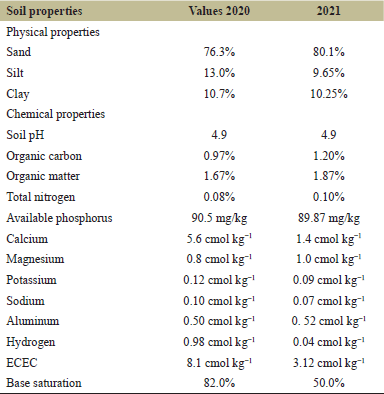 | Table 1. Pre-cropping physico–chemical properties of the soil at the experimental site. [Click here to view] |
2. MATERIALS AND METHODS
The field experiment was conducted during the early cropping season (June-August) 2020 and repeated in 2021 at the Crop Science Research Farm, in the precincts of the Forestry plantation of University of Calabar, Calabar (04o 58′N, longitude 08o 21′E) an altitude of 39 m above sea level at the equator, with a bi-modal annual rainfall that ranges from 3,000 to 3,500 mm/annum [26]. The plot was cleared of herbage, tilled, and partitioned into three blocks marking out the experimental units, and soil was raised into beds measuring 2.5 m wide × 2.1 m long (5.25 m2). Each bed was separated by 1.0 m spacing along the furrows. Lime was ploughed into the soil 1 week prior to sowing. Before field plowing, plot soil samples were collected from four different points at a depth of 0–15 cm using a soil auger, bulked, and made ready for routine physico–chemical analysis using appropriate methods. The experiment was 4 × 3 factorial laid out in a randomized complete block design (RCBD). Treatments comprised four levels of lime at 0, 0.5, 1.0, and 1.5 t ha−1 and 3 planting densities 30 × 30, 30 × 50 cm, and 25 × 50 cm (111,111, 66,667, and 80,000 plants ha−1). The 12 treatment combinations were replicated 3 times, giving a total number of 36 experimental units. The gross plot area was 320 m2 (10 × 32 m). SAMNUT 23 groundnut variety was sourced from the Institute of Agriculture and Research, Ahmadu Bello University, Zaria, Nigeria. The seeds were treated with seed guard chemicals to control soil-borne insect pests and fungal diseases. Two seeds were planted at 2–3 cm depth and later thinned to one plant/stand during the first weeding at 2 weeks after planting (2 WAP). The general fertilizer recommendation of NPK kg/ha is 25 kg of N, 50 kg of P2O5, and 100 kg of K2O as recommended by Okello et al. [27]. Weeds were hand hoed at 2 and 7 weeks after sowing, with earthing up of the plant bases to protect developing pegs and provide a loose medium for easy penetration and enlargement of pods. Data were collected on nine tagged plants from the net plot in each experimental unit on the following growth and yield attributes; Percentage emergence, plant height, number of leaves per plant, number of branches per plant, leaf area, number of roots, root length, total number of pods, number of unfilled pods, number of nodules, width of nodules, harvest index (%), and grain yield (t ha−1). The analysis of variance procedures for RCBD were done using the GenStat 10.3 DE edition, and the post-hoc test was done using Fisher’s least significant difference at a 5% level of probability as described by Gomez and Gomez [28].
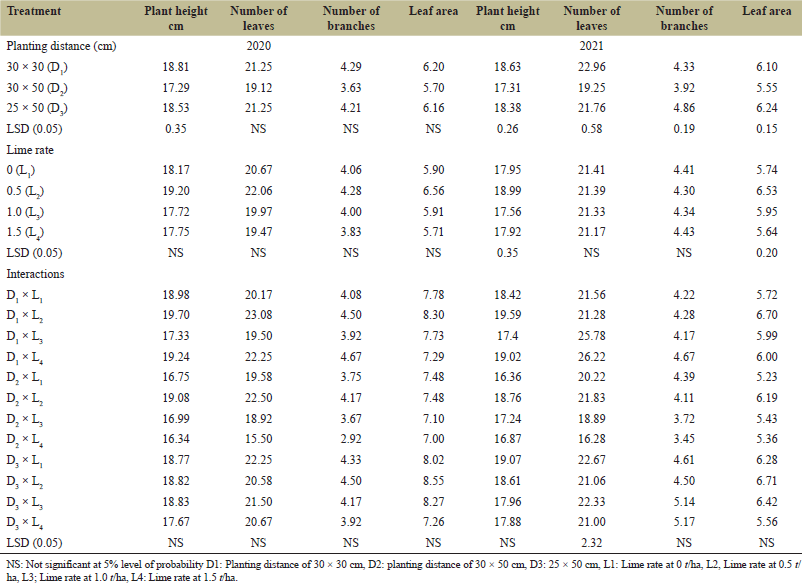 | Table 2. Plant height, number of leaves, and number of branches and leaf area of groundnuts at 5 WAP. [Click here to view] |
3. RESULTS
The physico–chemical properties of the soil at the experimental site are shown in Table 1. The soil at the site was classified as sandy loam with low pH (4.9) indicating acidic nature and requiring lime amendment. Low percentages of organic carbon (0.97% and 1.20%), organic matter (1.67% and 1.87%), total nitrogen (0.08% and 0.10%), low levels of magnesium (0.8 and 1.0 cmol kg−1), sodium (0.10 and 0.07 cmol kg−1), potassium (0.12 and 0.09 cmol kg−1) indicative of low nutrient status below acceptable or recommended baseline for groundnuts, but moderate in calcium (5.6 cmol kg−1), and available phosphorus (90.5 mg kg−1). The soil also contained low amounts of aluminum (0.50 and 0.52 cmol kg−1) and hydrogen ion (0.98 and 0.04 cmol kg−1) which are potential sources of soil acidity. Effective cation exchange capacity and base saturation values were (8.1 and 3.12 cmol kg−1) and (82.0% and 50.0%), respectively.
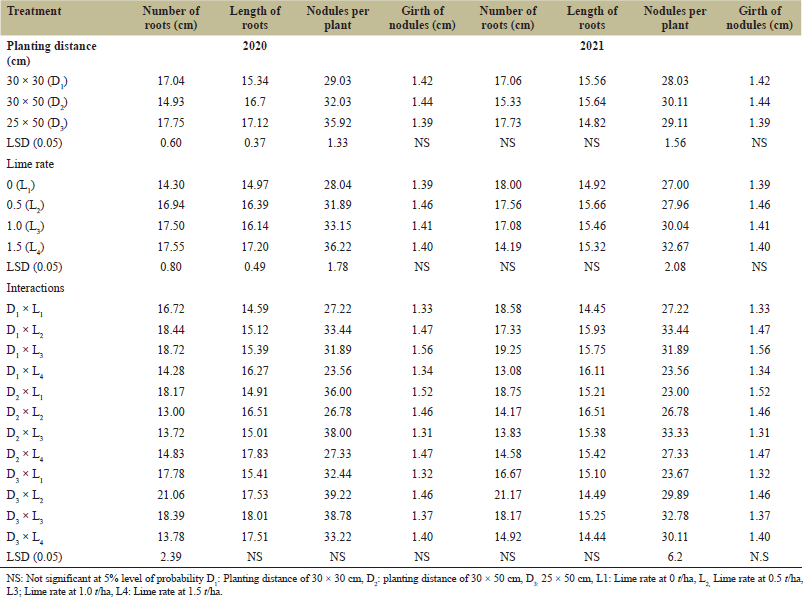 | Table 3. Effects of planting distance and lime application on number of roots, length of roots, nodules per plant, and girth of nodules of groundnut. [Click here to view] |
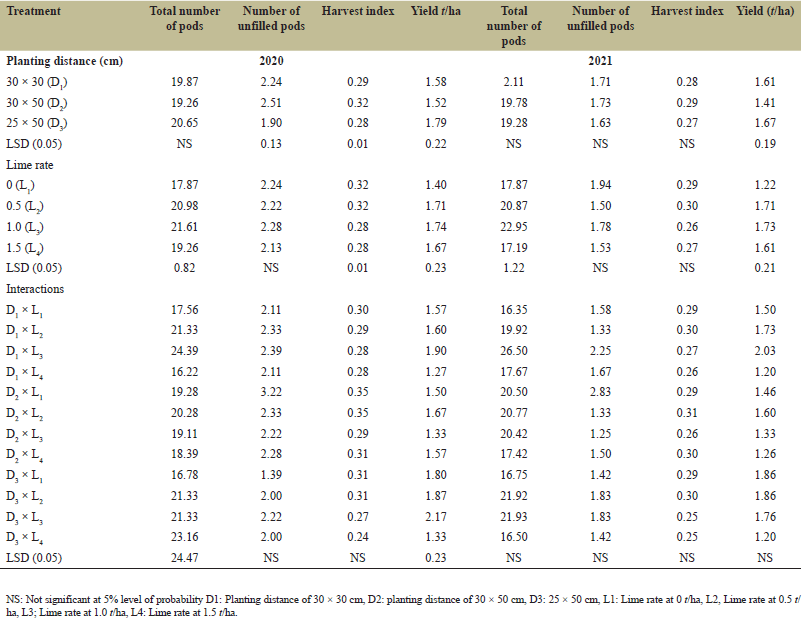 | Table 4. Effect of planting distance and lime application on total number of unfilled pods, harvest index, and yield (t/ha) of groundnut. [Click here to view] |
Results in Table 2 showed how planting distance and lime application impact the plant height, number of leaves, number of branches, and leaf area of groundnuts at 5 WAP in the two planting seasons. In 2020, plant height alone was significant, with 30 × 30 cm and 25 × 50 cm giving similar plant height which was significantly higher than height at 25 × 30 cm spacing. In 2021, spacing at 30 × 30 cm and 25 × 50 cm gave statistically similar results for plant height, number of leaves, number of branches, and leaf area, which were significantly higher than that observed at 30 × 50 cm in both years.
The lime levels were not significant in 2020 but only significant for plant height and leaf area in 2021. Applying lime at 0.5 t/ha significantly increased the plant height and leaf area than at all other liming rates (p < 0.05). Effects of lime and spacing interactions were however not significant (p > 0.05).
The effect of planting distance and lime application on the number of roots, length of roots, nodule numbers per plant, and girth of nodules; and their interactions is presented in Table 3. In 2020, the effect of planting distance on the number of roots, length of roots, and nodules per plant was significant (p < 0.05). The 25 × 50 cm planting distance resulted in the highest number of roots (17.75), longest roots (17.12 cm), and highest number of nodules (35.92) per plant while 30 × 50 cm gave the least values of these parameters except for nodule per plant where it was 30 × 30 cm. In 2021, the planting distance significantly (p < 0.05) affected nodule numbers per plant (27.00–32.67). The 30 × 50 cm planting distance gave the highest nodules per plant (30.11) while the least was produced by 30 × 30 cm (28.03).
The lime application rate showed a significant difference (p < 0.05) in the number of roots, length of roots, and nodules per plant in 2020 and the number of nodules per plant only in 2021. An increase in lime rates from 0–1.5 t/ha resulted in an increase in the relative number of roots, length of roots, and number of nodules per plant.
The interaction between planting distance and the lime rate was significant for the number of roots in 2021, which ranged from 13.00 to 21.06. The 25 × 50 cm in combination with 0.5 t/ha gave the highest number of roots while the least was obtained from 30 × 50 cm with 0.5 t/ha lime rate. In 2021, the result revealed that planting distance significantly (p < 0.05) affected nodules per plant of groundnuts only. The highest number of nodules per plant were obtained from 30 × 50 cm planting distance while the least was produced by 30 × 30 cm.
In 2020, planting distance significantly (p < 0.05) affected the number of unfilled pods, harvest index, and yield of groundnut. The spacing of 30 × 30 cm and 30 × 50 cm produced statistically similar yield which was significantly different (p < 0.05) from 25 × 50 cm at 1.79 t/ha. In 2021, 30 × 30 cm and 25 × 50 cm spacing resulted in statistically similar yields, significantly different from yield derived from 30 × 50 cm (Table 4).
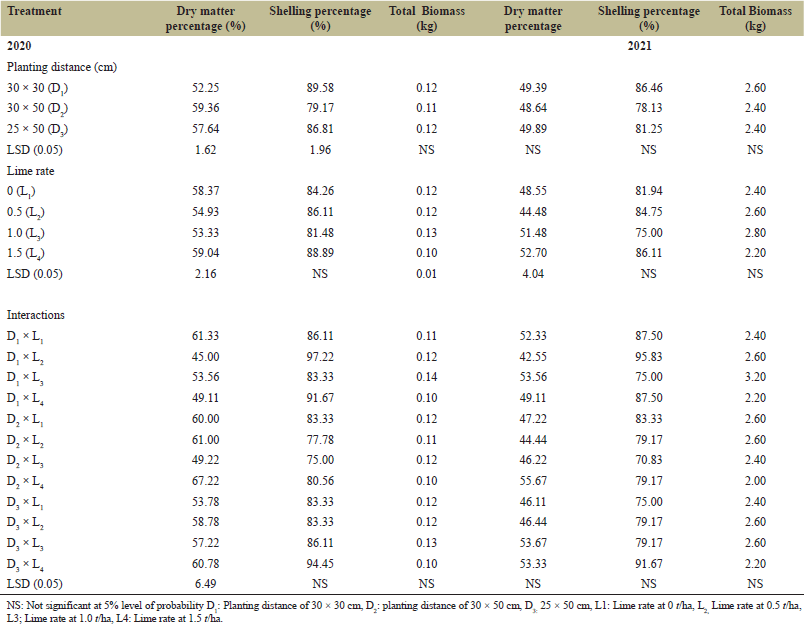 | Table 5. Effect of planting distance and lime application on dry matter percentage, shelling percentage, and total biomass of groundnut. [Click here to view] |
Similarly, lime application rates significantly affected the total number of pods, harvest index, and groundnut yield in 2020, as well as the total number of pods and yield alone in 2021. At 1.0 t/ha, lime produced the highest number of pods while the least was gotten from 0 and 1.5 t/ha. Lime application at 0.5–1.5 t/ha lime rate produced the highest yield (1.61–1.73 t/ha) which was statistically at par, while the least was obtained from 0 t/ha.
Planting distance and lime application rate interaction were significant for the total number of pods in 2020 and yield in 2020 only. The 30 × 30 cm in combination with 1.0 t/ha lime rate gave the highest number of pods while the least were from 30 × 30 cm planting distance with 1.5 t/ha lime rate. Groundnut had the lowest yield when lime was not applied (0 t/ha) and the highest yield at the lime application rate of 1.5 t/ha.
Planting distance and lime application rate interaction were significant for yield (t/ha) 30 × 30 cm interacted with 1.0 t/ha to give the highest yield while the least yield was obtained from 30 × 30 cm with 1.0 t/ha (Table 4).
The effects of planting distance and lime application on dry matter percentage, shelling percentage (%), and total biomass and their interactions (Table 5) in 2020 showed that planting distance significantly (p < 0.05) affected dry matter and shelling percentage but not total biomass. In 2021, however, the effect of planting distance was non-significant for dry matter, shelling percentage, and total biomass (p > 0.05). The application of lime only influenced dry matter percentage in both years and total biomass alone in 2020. The highest dry matter percentage was obtained from 30 × 50 cm planting distance while the least was from 30 × 30 cm. For the shelling percentage, 30 × 30 cm planting distance gave the highest while the least was from 30 × 50 cm.
The results further indicated that the effects of liming rate only significantly influenced dry matter percentage in 2020 (53.33–59.04) and 44.48–52.70 in 2021 only. The 0.5 t/ha and 1.0 t/ha lime rates were statistically similar in their dry matter percentage but statistically different from 0 to 1.5 t/ha lime rates (Table 5). The interactions between planting distance and lime rates were significant and ranged from 45.00% to 67.22%. The 30 × 30 cm in combination with zero application of lime gave the highest dry matter percentage while the least was from 30 × 30 cm with 0.5 t/ha lime rate. Other interaction effects were not significant (p > 0.05).
4. DISCUSSION
The result of the soil analysis in the experimental site before planting showed that the soil is sandy loam. The soil pH was low (4.9) indicating a strongly acidic condition which is in consonance with the report of Hazelton and Murphy [29]. There is adequate organic carbon above 0.75%, nitrogen, calcium, potassium, magnesium, and sodium whereas Available P and base saturation is high. The soil of this description has a low profile of essential nutrients [30] and, therefore, needs effective fertility management through the use of lime. The aluminum and hydrogen ion content in the soil is 0.50 and 0.98 cmol kg−1, respectively, while the effective cation exchange capacity is 8.1 cmol kg−1. To enhance crop production, farmers combat inherent low soil fertility through different strategies to enhance nutrient status [31]. However, liming has been found to be an effective remedy for soil acidity [29]. Kisinyo et al. [32] stated that when lime is applied to the soil, it reacts with water, leading to the production of OH− and Ca2+ ions which displace H+ and Al3+ ions from the soil absorption sites resulting in an increase in soil pH values.
From the results of this study, plant spacing on plant height were significantly different at different sampling periods. Plants grown at plant spacing of 30 × 30 cm were taller except at 7 WAP when the spacing of 25 × 50 cm became taller than those planted at 30 × 30 cm. This is consonant with Huber et al. [33] report that plants at close spacing, or high planting density per stand use rapid growth mechanism to avoid shade. Plant distance also significantly influenced the number of leaves and leaf area at 5 WAP but declined significantly at 7 WAP, possibly arising from the fact that leaf expansion ceased as the plant population increased.
Lime application rates significantly (p < 0.05) affected percentage emergence, groundnut height, number of leaves, and leaf area. Liming is said to unlock fixed nutrients under acidic soil conditions, making them available in the soil for better growth of plants. Lee et al. [34] in their findings stated that soil acidity causes the fixation of phosphorus by oxides of aluminum and iron while high concentrations of aluminum, hydrogen, and manganese in acidic soils cause root injury which affects the uptake of some important mineral nutrients in the soil which in turn impedes crops growth. Lime application rate also significantly (p < 0.05) influenced all the yield parameters except the number of unfilled pods and shelling percentage. This observation could be attributed to the increased phosphorus availability and improved nutrient uptake by groundnut plants [35]. Liming rate was not that effective on the number of nodules per plant as the lime rate at 1.0 t/ha resulted in the highest (36.22 cm) nodule and the lime rate at 1.5 t/ha resulted in the lowest (28.04 cm) nodules per plant. The lime rate at 0.05 t/ha gave the highest (20.98 cm) total number of roots and lower (17.87 cm) at a lime rate of 0 t/ha.
The interaction of plant density and liming increased the number of roots per plant and its effect on the percentage emergence was significantly (p ≤ 0.05) high at 100% in the interaction D3 × L4 t/ha. This could be attributed to increased phosphorus levels according to Sushil et al. [36] and El-Habbasha et al. [37]. The length of root and nodule per plant was significantly (p ≤ 0.05) influenced by plant density and liming though their interaction had no significant (p ≥ 0.05) effect on the length of root and nodule per plant. The plant yield was significantly (p ≤ 0.05) improved by the interaction effect of plant density and liming rate. Maximum yield (2.16 t/ha) was obtained at the interaction (D3 × L1) and minimum (1.26 t/ha) at the interaction (D1 × L4). These results indicate that the groundnut yield increased with increasing plant density and liming rate interaction applied and it agrees with that of several researchers [38] that crop yield is determined by the efficiency with which plants mobilize resources for growth and that equidistant spacing between plants will provide maximum yield, through minimized inter plant competition with phosphorus mediating in the increased seed yield.
The interaction between plant density and liming favored significantly (p ≤ 0.05) the production of dry matter with 67.22% being the highest percentage of dry matter of all other treatments. This result agrees with [39,40] observations that dry matter and seed development of peanuts increased with phosphorus level which is the role of liming in the soil.
5. CONCLUSION
A field trial was carried out at Crop Science Research Farm, University of Calabar, Nigeria, to determine the influence of lime application rates and planting distances on the performance of groundnut. There was a significant effect of planting distance on plant height in both years, number of leaves, number of branches, and leaf area in 2021 only. The number of pods in both years was not significant but yield in both years was significant. Also, the results revealed a significant difference in lime application increased the yield of groundnuts in both years. A significant interaction between planting distance and lime application on a total number of pods and yield in 2020 only was observed. In conclusion, planting distance of 25 × 50 cm and lime applied at the rate of 1.0 t/ha is recommended for effective groundnut production in the study area.
6. AUTHOR CONTRIBUTIONS
All authors made substantial contributions to conception and design, acquisition of data, or analysis and interpretation of data; took part in drafting the article or revising it critically for important intellectual content; agreed to submit to the current journal; gave final approval of the version to be published; and agree to be accountable for all aspects of the work. All the authors are eligible to be an author as per the international committee of medical journal editors (ICMJE) requirements/guidelines.
7. FUNDING
There is no funding to report.
8. CONFLICTS OF INTEREST
The authors report no financial or any other conflicts of interest in this work.
9. ETHICAL APPROVALS
This study does not involve experiments on animals or human subjects.
10. DATA AVAILABILITY
All the data is available with the authors and shall be provided upon request.
11. PUBLISHER’S NOTE
All claims expressed in this article are solely those of the authors and do not necessarily represent those of the publisher, the editors and the reviewers. This journal remains neutral with regard to jurisdictional claims in published institutional affiliation.
12. USE OF ARTIFICIAL INTELLIGENCE (AI)-ASSISTED TECHNOLOGY
The authors declares that they have not used artificial intelligence (AI)-tools for writing and editing of the manuscript, and no images were manipulated using AI.
REFERENCES
1. Witcombe AM, Tiemann LK. Potential contribution of groundnut residues to soil N and the influence of farmer management in Western Uganda. Front Sustain Food Syst 2021;5:1–18.
2. Abady S, Shimelis H, Janila P, Mashilo J. Groundnut (Arachis hypogaea L.) improvement in sub-Saharan Africa: a review. Acta Agric Scand Sec B—Soil Plant Sci 2019;69:1–19.
3. Oteng-Frimpong R, Dakora FD. Multi-environment testing for trait stability and G × E interaction on N2 fixation, plant development, and water-use efficiency of 21 elite groundnut (Arachis hypogaea L.) genotypes in the Guinea Savanna. Front Plant Sci 2019;10:1070.
4. Taru VB, Kyagya IZ, Mshelia SI. Profitability of groundnut production in Michika Local Government Area of Adamawa State, Nigeria. J Agric Sci 2010;1(1):25–9.
5. USDA-FAS. United States Department of Agricultural Service peanut area, yield, and production. USDA-FAS, Washington, DC. Available via http://www.fas.usda.gov/psdonline/psdQuery.aspx (Accessed 2 October 2023)
6. Uko AE, Effa EB, Isong AI. Tillage methods and poultry manure application effects on the growth and yield of groundnut (Arachis hypogaea L.) in Calabar, Nigeria. J Agron 2018;17(4):188–97.
7. Shoman H. Resistance of peanut to heat stress through subsurface irrigation and intercropping with sorghum under new valley condition. Egypt J Desert Res 2024;74:89–107.
8. Abdel-Galil A. Effect of groundnut—sesame intercropping and nitrogen fertilizer on yield, yield components and infection of root—rot and wilt diseases. Int J Plant Soil Sci 2014;3:623–43.
9. Wolde DT, Woundefiraw B, Tesfay W. Technical efficiency of groundnut production: the case of North Western Ethiopia. Int J Agric Econ 2023;8(6):238–44.
10. Isah A, Sapuan SM, Zainudin ES, Mohamed Y, Mohd Z, Yahaya R, et al. An overview of mechanical and corrosion properties of aluminium matrix composites reinforced with plant based natural fibres. Phys Sci Rev 2022;9:124–39.
11. Campos SB, Oliveira Filho JG, Salgaço M, Jesus MH, Egea M. Effects of peanuts and pistachios on gut microbiota and metabolic syndrome: a review. Foods 2023;12(24):4440.
12. Arya SS, Salve AR, Chauhan S. Peanuts as functional food: a review. J Food Sci Technol 2012;53(1):31–41.
13. CARP, Centre For Agriculture and Rural Development Policy Research. 2022. Available via https://angrau.ac.in/downloads/AMIC/OutlookReports/2022/10-Groundnut%20Outlook%20Report%20-%20January%20to%20December%202022.pdf (Accessed 11 October 2023)
14. Udoh DJ, Ndon BA. Crop production techniques for the tropics. 2nd edition, Concept Publishers Ltd, Lagos, Nigeria, p 592, 2010.
15. Tisdale SL, Nelson WL, Beaton JD, Havlin JL. Soil acidity and basicity. In: Soil fertility and fertilizers. 5th edition, Macmillan Publishers, New York, NY, pp 364–404, 2010.
16. Paradelo R, Virto I, Chenu C. Net effect of liming on soil organic carbon stocks: a review. Agric Ecosyst Environ 2015;202:98–107.
17. Qaswar M, Dongchu L, Jing H, Tianfu H, Ahmed W, Abbas M, et al. Interaction of liming and long-term fertilization increased crop yield and phosphorus use efficiency (PUE) through mediating exchangeable cations in acidic soil under wheat–maize cropping system. Sci Rep 2020;10:19828.
18. Effa EB, Uwah DF, Ukeh DA. Yield response of popcorn (Zea mays L. var. everta) to nitrogen and lime amendment in a South Eastern Rainforest Environment of Nigeria. Am J Plant Physiol 2011;6(6):304–11.
19. Bossolani JW, Crusciol CAC, Momesso L, Portugal JR, Moretti LG, Garcia A, et al. Surface liming triggers improvements in subsoil fertility and root distribution to boost maize crop physiology, yield and revenue. Plant Soil 2022;477:319–477.
20. Liao P, Ros Mart BH, Van Gestel N, Sun Y, Zhang J, Huang S, et al. Liming reduces soil phosphorus availability but promotes yield and P uptake in a double rice cropping system. J Integr Agric 2020;19(11):2–9.
21. Uko AE, Effa EB, Isong AI. Performance and dry matter accumulation of groundnut in an Ultisol Amended with phosphorus and lime. Pak J Biol Sci 2021;24(8):847–57.
22. Rastija M, Simic D, Lalic A. Impacts of liming with dolomite on maize, wheat and barley yields. Novenytermeles 2010;5(9):65–8.
23. Kovacevic V, Rastijia M. Impacts of liming with dolomite on maize and barley grain yield. Poljoprivreda 2010;16(2):3–8.
24. Onat B, Bakal H, Gulluoglu L, Arioglu H. The effects of row spacing and plant density on yield and yield components of peanut grown as a double crop in Mediterranean environment in Turkey. Turk J Field Crops 2017;22(1):71–80.
25. Sreelatha P, Sudhakar P, Umamahesh V, Subramanyam D, Vasanthi RP. Variability in growth and yield attributes among different growth habits of groundnut genotypes. Int J Curr Microbiol Appl Sci 2019;8(6):1066–71.
26. NIMET . Nigerian Meteorological Agency, Calabar, Nigeria, 2019.
27. Okello DK, Monyo E, Deom CM, Ininda J, Oloka HK. Groundnuts production guide for Uganda; recommended practices for farmers. National Agricultural Research Organization, Entebbe, Uganda, p 34, 2013.
28. Gomez KA, Gomez AA. Statistical procedures for agricultural research. 1st edition, John Wiley and Sons Inc., New York, NY, p 690, 1984.
29. Hazelton PA, Murphy BW. Interpreting soil test results: what do all the numbers mean? CSIRO Publishing, Australia, Clayton, pp 1–152, 2007.
30. Alemu E, Yihenew SG, Yitaferu B. Effect of lime on selected soil chemical properties, Maize (Zea Mays L.) yield and determination of rate and method of its application in Northwestern Ethiopia. Heliyon 2022;8:1–8.
31. Effa EB, Alawa DA, Ajah EA, Isong IA, Uko AE, Etimita IC, et al. Co-application of neem-based biochar with poultry manure and its implications for sustainable production of cucumber (Cucumis sativus Linn.) in humid tropical soil. J Appl Biol Biotechechnol 2023;11(6):94–100.
32. Kisinyo PO, Gudu SO, Othieno CO, Okalebo J, Opala, SR, Machanga PA, et al. Effect of lime, phosphorus and rhizobia on Sesbania sesban performance in Western Kenyan acid soil. Afr J Agric Res 2012;7(18):2800–9.
33. Huber M, Nicole M, Chrysoula K, Ronald P. Light signaling shapes plant-plant interactions in dense canopies. Plant Cell Environ 2021;44(4):1014–29.
34. Lee CH, Lee H, Lee YB, Chang, HH, Ali MA, Kim S, et al. Increase of phosphorus by fly- ash application on Paddy soil. Commun Soil Sci Plant Anal 2007;38:1551–62.
35. Sharma R, Sarita C, Bamboriya JS, Yadav SS. Nutrient uptake, quality traits and yield of groundnut as influenced by integrated phosphorus management. IJBSM 2020;11:195–200. Available via http://ojs.pphouse.org/index.php/IJBSM/article/view/4002
36. Sushil K, Matta NK, Kumar S. Status of groundnut and Mung bean protein fractions under changing nutrient regime. J Plant Biochem Biotechnol 1997;6(1):41–3.
37. El-Habbasha SF, Kandil AA, Abua-Hagaza NS, Abd-El-Haleem AK, Khalafallah MA, Behairy TG. Effect of phosphorous levels and some bio-fertilizers on dry matter, yield and yield attributes of groundnut. Bull Fac Agric Cairo Univ 2005;56:237–52.
38. Ayman MH, Mohamed FR. Yield quality parameters and chemical composition of peanut as affected by potassium and gypsum applications under foliar spraying with boron, communications in soil science and plant analysis 2014;45(18):2397–412.
39. Dessalegn A. Effect of lime and phosphorus on yield and yield components of groundnut varieties (Arachis hypogaea L.) on acidic soil in Nedjo District, Western Ethiopia. Agric Sci 2023;14:1653–74.
40. Ghulam M, Ali S, Hafiz SH, Anum B, Muhammad S, Kamran G, et al. Effect of nitrogen and phosphorus application rate on peanut (Arachis hypogaea L.) phenology, yield and soil nutrient status. J Arable Crops Marketing 2022;4(2):143–53.